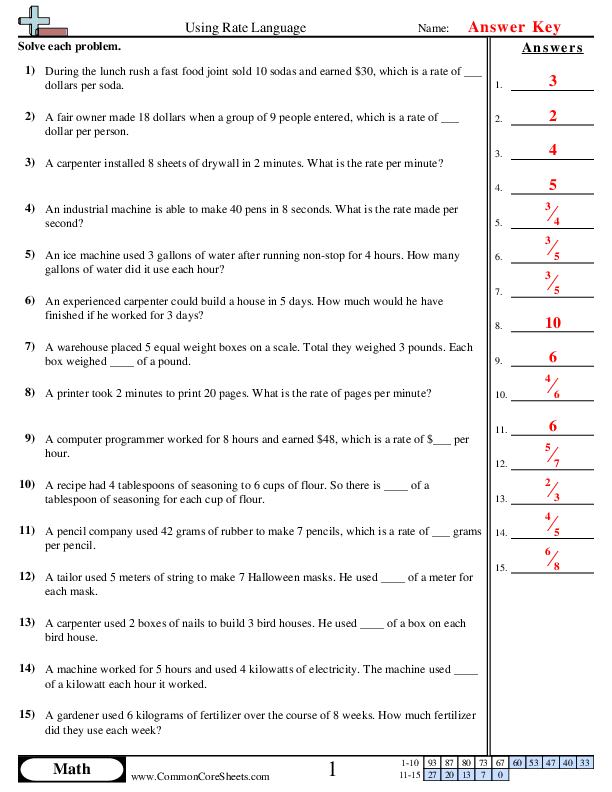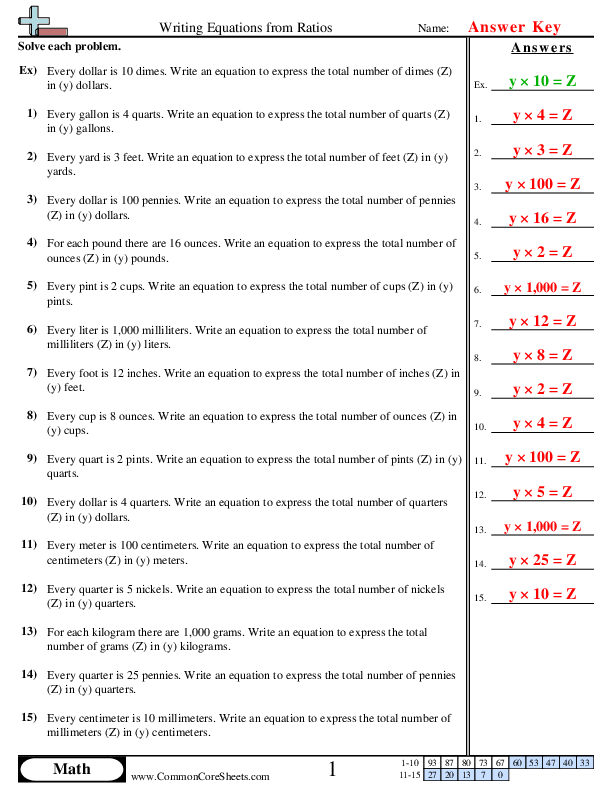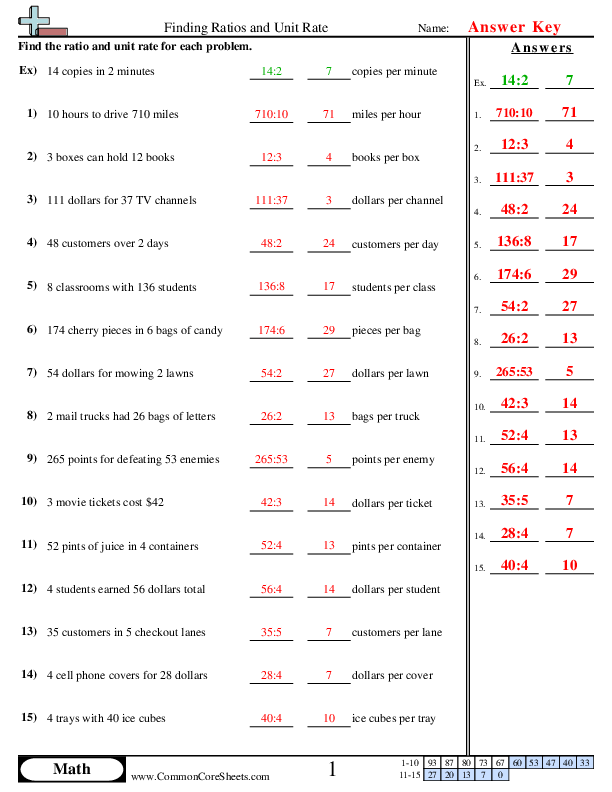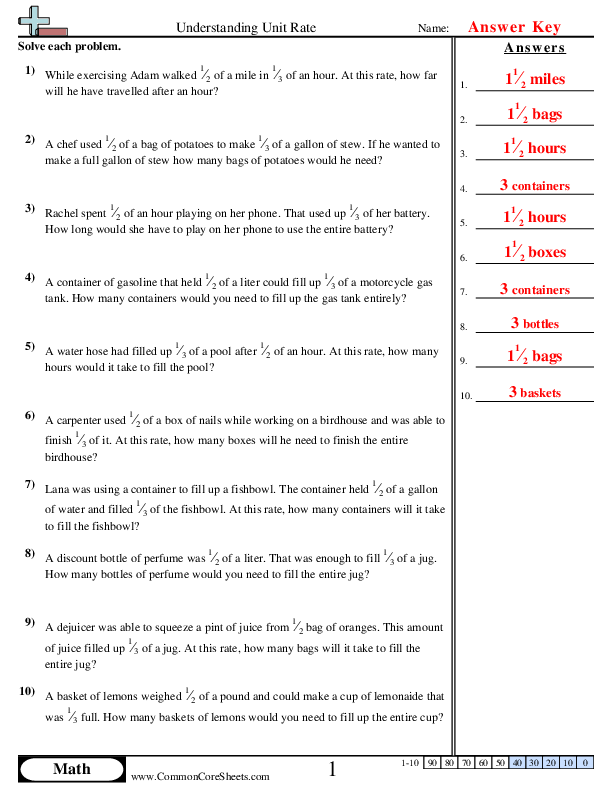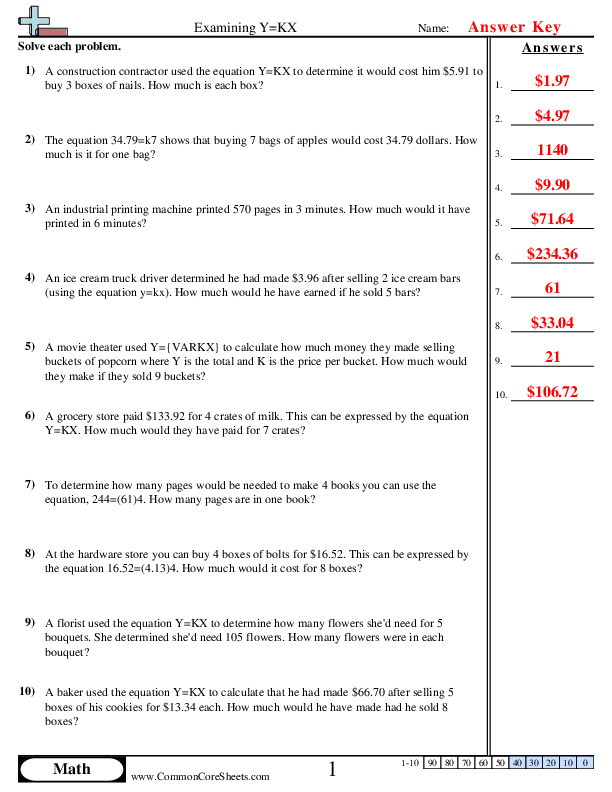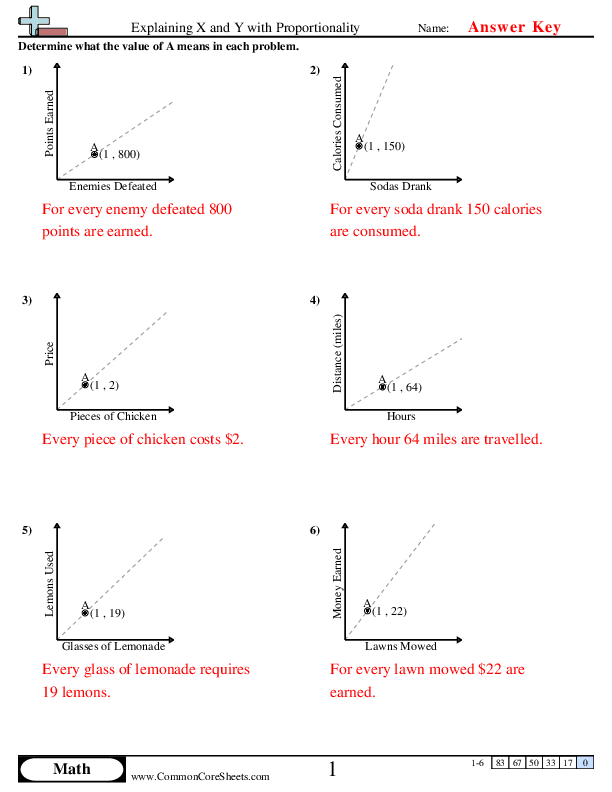Are you looking for the best ratio worksheets on the internet? Look no further - we have the perfect set of free ratio worksheets for you. Our ratio worksheets give students the opportunity to practice and reinforce their understanding of how to use ratios in real-world situations. Our worksheet includes examples, visual diagrams, and practice problems that will help your students gain a better understanding of how to properly work with ratios. With our ratio worksheets, you can be sure that your students are learning the concepts they need to succeed. So don't hesitate and try our free ratio worksheets today!
Browse Sheets By Problem Type
×
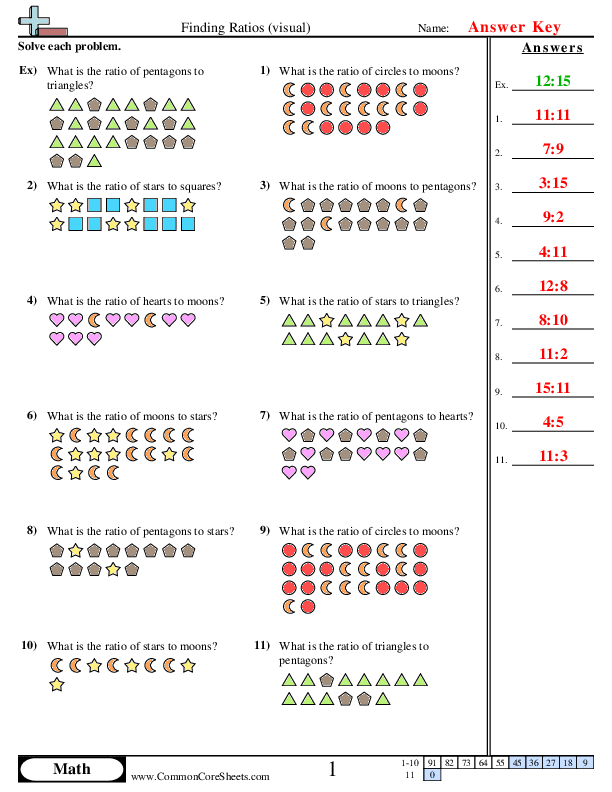
Finding Ratios Visual
6rp1


×
Description:
"This worksheet is designed to give children a visual approach to understanding ratios in math. Through 11 customizable problems, it uses various shapes like moons, squares, hearts, triangles, circles, and stars to teach the concept of ratios. Suitable for distance learning, this worksheet can also be converted into flashcards for easier recall and practice."

×
Student Goals:
Ratio Comparison SkillsAfter completing the worksheet, students should have developed and improved their ability to understand and apply ratio comparison skills. They should be well-versed with the concept of ratios, the relation it establishes between two quantities of the same kind, and the representation of this relationship. The problems in the worksheet encourage students to create a visual image and provide an understanding that a ratio is a comparison of two quantities. This could be a powerful tool for them to tackle practical problems involving comparisons.Critical Thinking and Problem SolvingStudents should be capable of handling situations that demand critical thinking. The math problems given make them analyze and establish a quantitative relationship between different shapes. This competency not only enhances their counting skills but also develops their problem-solving abilities. They should be able to apply these analytical skills in real life scenarios.Mathematical Language ProficiencyBy engaging with the worksheet, students should have improved their mathematical vocabulary and language proficiency. Terms like ratios, pentagons, squares, and triangles would become a part of their regular vocabulary, which will facilitate further mathematical learning. Gains in such a specific language domain can benefit students in their daily communication about quantities, numbers, and shapes.Confidence and IndependenceAfter solving all of the problems in the worksheet, the students should have gained confidence and become independent in tackling similar math problems on their own. This progression to independence signifies that they can handle such math problems in their exams or homework without needing constant assistance.Application of KnowledgeAfter completion, students should be in a position to apply their acquired knowledge to other mathematical problems and real-life scenarios. The understanding of ratios can be extended to varied contexts, such as determining proportions in cooking recipes, understanding scales on maps, or comparing statistical data. Therefore, the application of this knowledge will be far-reaching and quite practical.


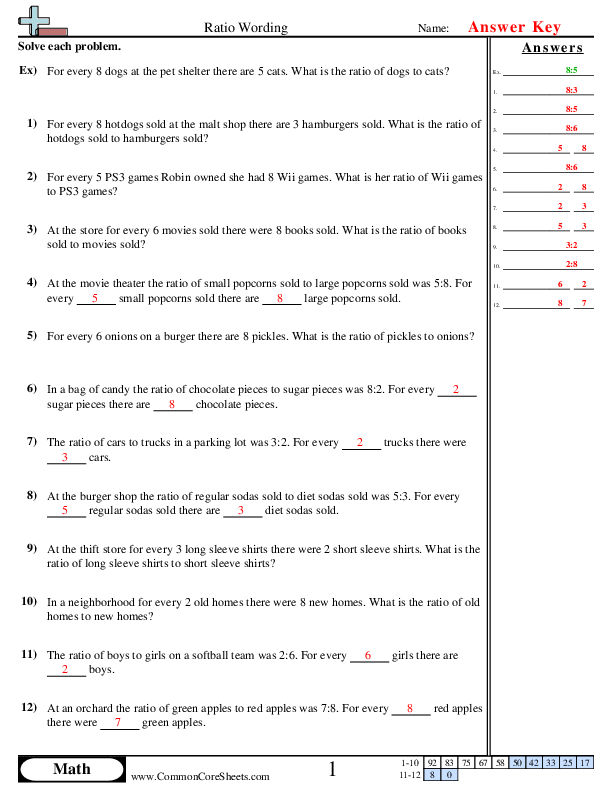
Ratio Wording
6rp1


×
Description:
This worksheet is designed to enhance children's understanding of mathematical ratios. It contains 12 carefully crafted problems, addressing practical examples such as vote distributions, home ages, combined genders, types of vehicles, clothing items, and game consoles. With features to customize, convert to flashcards, and adapt for distance learning, it's a versatile tool supporting varied learning approaches and styles. Ideal for encouraging in-depth comprehension of ratios in real-world contexts.

×
Student Goals:
Problem Solving SkillsStudents should be able to enhance their problem solving skills. Solving ratio problems often requires logical thinking and the application of foundational math principles. By working through the worksheet, learners will be able to grasp these core steps, aiding in their overall problem-solving abilities.Understanding of RatiosUpon completion of this worksheet, students should have a deeper understanding of ratios. They should be able to confidently distinguish and interpret ratios in multiple contexts. This foundational understanding of ratios is crucial in many areas of mathematics and everyday life situations. Therefore, accomplishing this worksheet signifies a significant step in the maturation of their mathematical competencies.Application of RatiosBy completing the worksheet, students should be able to apply the concept of ratios in real-life situations. The problems simulate real-world scenarios and train students to equate and understand ratios in various contexts. This capability is beneficial as the concept of ratios extends beyond classroom learning into elements of daily life.Critical ThinkingThis worksheet aids in the development of students' critical thinking skills. By tackling these problems, students will learn to identify the most effective strategies to use when calculating ratios. They will be capable of analyzing the information given, relating the parts to the whole, and determining the relationship between the different components, thereby enhancing their critical thinking skills.Mathematical CommunicationIn completing the worksheet, learners should improve their mathematical communication ability. This involves the use of proper mathematical language and symbols. Students will learn how to accurately articulate their understanding of ratios, both orally and in writing, fostering better mathematical communication.Confidence with NumbersAfter successfully completing this worksheet, students should feel more confident working with numbers and see the practical applications of their learning. They will be able to approach mathematical problems with less apprehension and more confidence, being self-assured in their own abilities to calculate ratios.



Reducing Ratios
6rp3c


×
Description:
"This worksheet is designed to enhance children's understanding of reducing ratios in math. Comprising of 20 engaging problems, children can learn to simplify ratios such as 24:54 to 4:9. The content is customizable, offering flexibility for different learning approaches. It can be conveniently converted into flashcards or integrated into distance learning modules, making math education accessible and effective."

×
Student Goals:
Understanding RatiosAfter completing this worksheet, students will have a clear understanding of ratios and their practical applications. They will be skilled at identifying, interpreting, and reducing ratios in different situations.Enhancing Numerical ProficiencyStudents will advance their numerical proficiency by practicing the process of reducing ratios. This process requires them to simplify numbers while maintaining their relationship—a key mathematical skill. This further aids creative problem-solving abilities and fosters numerical manipulation skills.Critical Thinking and Problem-Solving SkillsThis worksheet will help students develop critical thinking and problem-solving skills. They will learn to analyze problems by breaking down numbers and discerning their relationships. This form of analytical thinking is crucial for understanding broader mathematical principles and solving complex math problems.Real-world Mathematical ApplicationsBy successfully reducing ratios, students will be better equipped to understand real-world applications of math. Ratios can be found in everyday situations like recipes, proportions in drawings, scaling models and more. Grasping ratios will help students apply mathematical concepts beyond the classroom.Mathematical ConfidenceBy solving these problems, students will gain confidence in their mathematical abilities. Each successfully reduced ratio will serve as a confidence builder, supporting them in tackling increasingly complex mathematical problems. This confidence is essential for fostering an enduring interest in mathematics and higher levels of mathematical education.Independent Learning and PracticeCompleting this worksheet will also promote independent learning as students work alone to solve each problem. This will enhance their capability to think independently, an important skill for lifelong learning.Time Management SkillsFinally, by working through a set number of problems, students will improve their time management skills. They will learn to allocate sufficient time to each problem, promoting a more efficient approach to solving math problems and aiding their overall academic progress.



Understanding Ratios (Word)
6rp3c


×
Description:
"This worksheet is designed to enhance children's understanding of ratios in a fun and interactive way, through vivid real-life examples. Covering a range of scenarios from race times to soda sales to video game levels, this 10-problem activity sharpens math skills and improves conceptual knowledge. Not only can this worksheet be personalized to suit individual learner needs, it can also be transformed into flash cards or utilised effectively in distance learning environments."

×
Student Goals:
Understanding of RatiosAfter completing the worksheet, students should have a firm grasp on the concept of ratios. They should understand what a ratio is and how to interpret it, being able to relate quantities in a meaningful way. They should also be able to distinguish when ratio is used in a sentence, and identify the quantities being compared.Application of RatiosSuccessfully completing the worksheet should equip students with the ability to apply ratios to practical, real-life situations, be it a movie rental story, a parking lot dilemma, or a pet store sales analysis. They'll be able to contextualize and calculate ratios in various scenarios, making them more confident in their math abilities.Problem-solving SkillsThrough the math problems provided, students will reinforce their problem-solving skills. They'll be tasked with determining how to extract the necessary information from problems, use it to create a ratio, and then solve for the ratio. As a result, they should see a notable improvement in their problem-solving capabilities.Mathematical ReasoningUpon worksheet completion, students' mathematical reasoning will be markedly improved. Ratios entail critical thinking skills, as students must understand the comparison and relationship between two quantities. This will enhance their ability to think critically in a mathematical context, and cultivate logical thinking patterns.Ratio ConversionA part of understanding ratios is knowing how to convert them into different forms or units. Therefore, after this worksheet, students should be competent in converting ratios to different formats, such as fractions, decimals, or percentages. This knowledge will serve as a building block for future topics in mathematics.Communication of Mathematical IdeasLastly, students should be proficient in communicating mathematical ideas more effectively after working through this worksheet. The ability to express the reasoning behind a solution is fundamental in learning. So, being able to explain how a ratio is derived and used to solve a problem is a vital gain from this exercise.


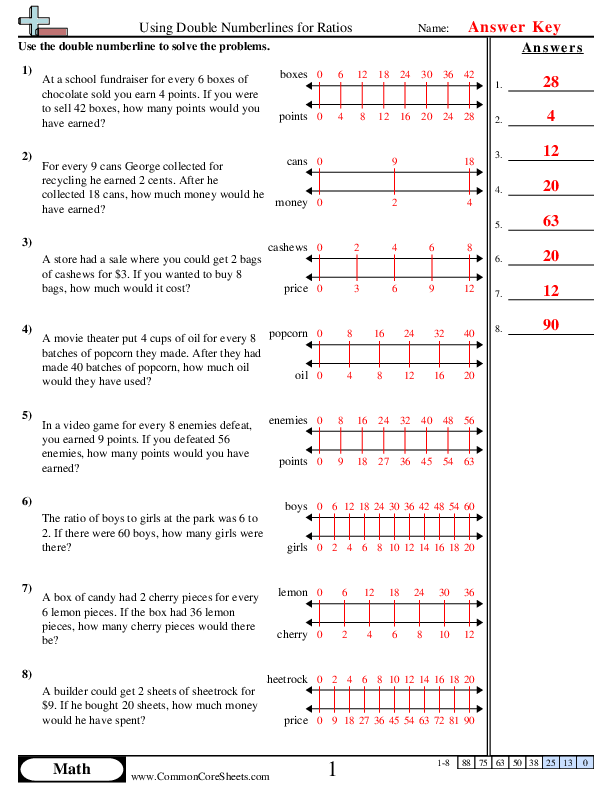
Ratios Double Line
6rp3b


×
Description:
"This worksheet is designed to help children grasp the concept of ratios using double numberlines effectively. With real-world situations contextualized in 8 unique math problems, learners can deepen their understanding, and further apply this skill. The flexible format allows customization, conversion to flash cards, or use in distance learning, catering to various learning styles and environments."

×
Student Goals:
Understanding of RatiosAfter completing the worksheet, students will have a solid understanding of ratios. They will be able to interpret and apply the concept of ratios in a variety of real-life situations like proportions of ingredients in a recipe or pricing of items in bulk. This foundational knowledge is critical in many aspects of numeracy and is often applied in higher-level mathematics.Problem-Solving AbilitiesThis worksheet aids in honing students' problem-solving abilities. Each problem tasks students with calculating quantities based on given ratios, which requires both critical thinking and arithmetical skills. By working through these problems, students will become more proficient at approaching and solving mathematical challenges.Application of Number Line ConceptWith the completion of the worksheet, students will be adept at using number lines as a visual aid in the understanding of ratios. They will be able to associate the concept of ratios with the practical visual model of a number line, helping them to better understand and solve problems involving ratios.Master of Multiplication and DivisionAs students engage with this worksheet they will practice essential mathematical operations, particularly multiplication and division. This is due to the nature of processing proportions and ratios. Regular engagement in these operations will help students become proficient and increase their speed in mathematical computations.Conceptual Understanding of Proportional RelationshipsProportional relationships are a key aspect of this worksheet. After completion, students will be able to identify and understand these relations in various settings. They will be able to relate real-life situations to corresponding mathematical expressions, ratios, or equations, consolidating their understanding of these abstract concepts.Enhanced Mathematical LiteracyLast but not least, upon successful completion of the worksheet, students will gain significant strides in widening their mathematical literacy. This involves not just the ability to solve problems, but also a comprehension of why the solutions work. Hence, they can apply this knowledge to tackle similar problems in the future, thereby making them more mathematically autonomous and confident learners.


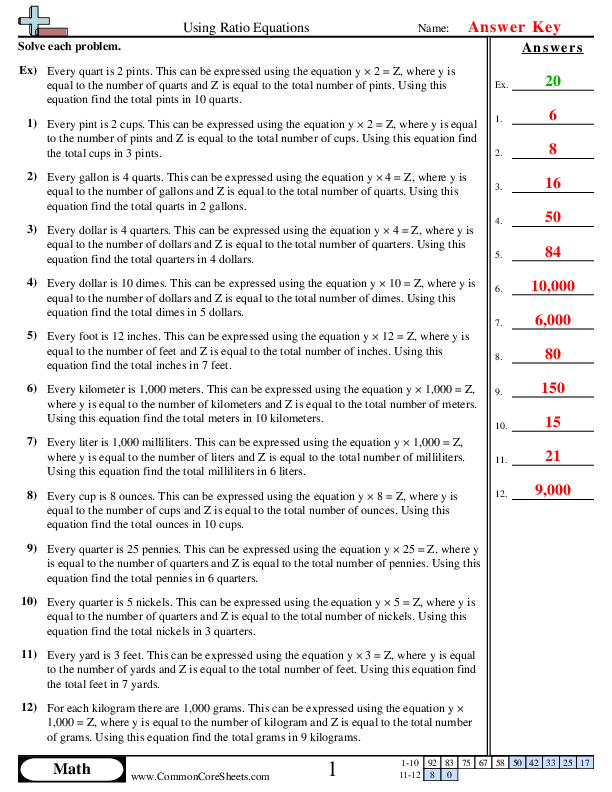
Using Ratio Equations
6rp3d


×
Description:
"This worksheet is designed to enhance children's mathematical skills, particularly in using ratio equations. It comprises of 12 problems involving conversion of units in everyday items such as currency, measurement, and volume. With practical examples, children can better understand and apply the concept. The worksheet is customizable, can be converted into flashcards for easy learning and is suitable for distance learning, promoting a flexible and interactive educational experience."

×
Student Goals:
Understanding of RatiosUpon completion of the worksheet, students should have a thorough understanding of ratios. This allows them to make sense of the relations between different amounts and magnitudes in real-world situations, such as converting feet to inches or dollars to cents. The principle of ratio enables students to see how different quantities relate to each other, which is a critical aspect of mathematical and analytical thinking.Grasping Mathematical EquationsStudents should also be able to grasp mathematical equations, specifically understanding what each variable in a ratio equation represents and how they can be manipulated to find the unknown values. This understanding forms the basis for more complicated algebraic expressions they may encounter in future math lessons.Problem Solving SkillsCompleting the worksheet enhances the students' problem-solving skills. They are given questions and required to find solutions using the given equations, which encourages them to think critically, apply what they have learned and solve problems systematically.Application of Mathematics in Real World ScenariosBy the end of the worksheet, students should be able to apply mathematical concepts to real-world scenarios. Each problem in the worksheet underscores how mathematics, especially ratios, can be seen and used in everyday life, like converting liters to milliliters or yards to feet. This alignment of mathematics to real-world contexts aids in making the subject more relevant and understandable for the students.Enhance Computational SkillsFinally, students should develop and enhance their computational skills. They perform numerous calculations to solve problems that reinforce arithmetic principles. This practice will help improve their speed, accuracy, and confidence in performing basic operations that lay the groundwork for complex mathematical problems that they will face in their future studies.


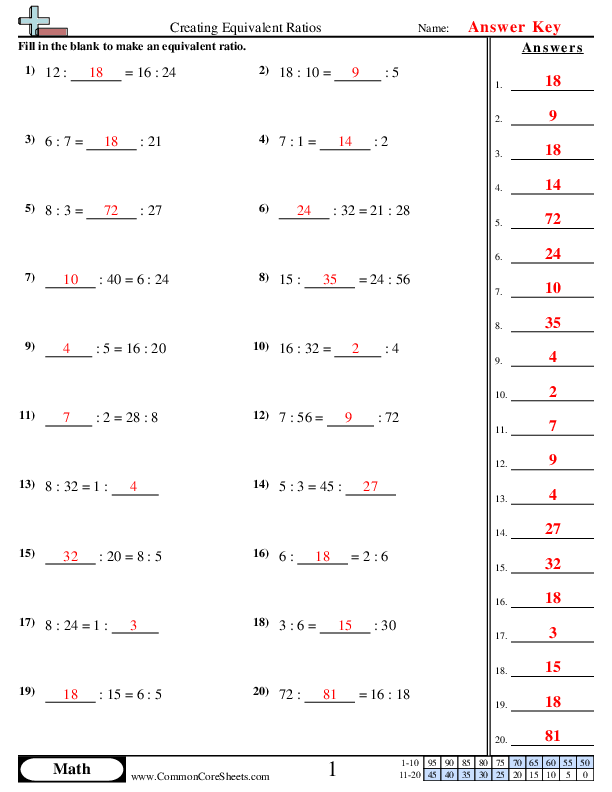
Creating Equivalent Ratios
7rp2a


×
Description:
"This worksheet is designed to teach children about equivalent ratios in a fun and engaging way. The math worksheet contains 20 easily comprehensible ratio problems aimed to sharpen young minds. Ideal for customization, it can be converted into interactive flash cards or incorporated into distance learning platforms. A key tool to boost your child's numerical literacy and problem-solving abilities."

×
Student Goals:
Understanding and Applying Ratio ConceptsUpon completing the worksheet, students should be able to demonstrate a deep understanding of ratio concepts. They should be proficient in recognizing and creating equivalent ratios. Also, they are expected to apply their knowledge to real-life contexts, thus improving their problem-solving skills.Mathematical Skills DevelopmentThrough the completion of the worksheet, students will refine their mathematical skills, specifically in forming and solving ratio problems. They should be able to identify the connection between ratios, fractions, and relative sizes, understanding how to use ratios to compare quantities and to scale figures.Enhanced Analytical SkillsThis exercise will contribute significantly to improving students’ logical and analytical capabilities. By consistently engaging with the problems, they will develop the skills needed to analyze complex situations, identify relevant quantities, and deduce relationships among them.Improvement of Calculation Accuracy and SpeedThe worksheet provides plenty of practice to become more accurate and swift in their mathematical calculations, which is a valuable lifelong skill. They should be able to quickly identify and create equivalent ratios with improved precision and speed. Students will also gain practice in mental math and number comprehension.Boosted Confidence in MathematicsSuccessfully tackling these exercises will build the students' confidence in their mathematical abilities. The more comfortable they become with working on ratio problems, the more their self-assurance will grow. This would lead to more active engagement and participation in class and other mathematical discussions.Increased Pattern RecognitionAfter completing the worksheet, students should have strengthened their skill in recognizing and extending patterns within the structure of the ratios. Their ability to identify the relationships and patterns among numbers is a fundamental mathematical skill and a useful tool in reasoning and problems solving in real-life situations.Preparation for Advanced Math TopicsKnowing how to work with ratios is crucial for understanding more advanced mathematical topics like proportions, rate, and percentage, among others. After finishing this worksheet, students will be well-prepared to tackle these more advanced subjects in future lessons.



Determining Proportionality with Tables
7rp2a


×
Description:
"This worksheet is designed to educate children about the concept of proportionality in math. Through 12 problem sets, learners uncover relational values via tabular representation. With the ability to convert content into flash cards, the worksheet supports both in-person and distance learning. Depending on learners' needs, its content can be customized to promote active learning and cater to individual pace and level."

×
Student Goals:
Understanding of Proportional RelationshipsWith the completion of this worksheet, students would understand the core concept of proportional relationship through tables. By working with tables carrying different values, they can comprehend how altering one quantity impacts another quantity and their relationship. They'll accurately discern if two quantities are proportional by observing the consistency in ratios.Proficiency in Problem SolvingCompletion of the worksheet means the students have exercised their problem-solving skills by applying their learned concepts of proportional relation in everyday situations. This enhances their arithmetic acuity and critical thinking, which are vital skills for academic progress and for facing real-world challenges.Improvement in Mathematical ReasoningWorking through this set of problems, students upgrade their mathematical reasoning skills. They will be able to interpret and evaluate the data arranged in tables to uncover patterns, identify anomalies, and draw conclusions. These skills are crucial not only in maths but in various scientific and technological disciplines.Mastering Core Math ConceptsBy finishing the worksheet, students would have mastered the core math concept of ratios, rates, and proportional relationships. For instance, they can now understand how ratios and rates are created, used, and interpreted in different contexts. This foundational knowledge is essential for learning more complex mathematics topics in the future.Increase in ConfidenceSuccessfully navigating varied and challenging mathematical problems increases students' confidence in their mathematical abilities. This confidence inevitably reflects in their academic performance and can even help foster a more positive relationship with the subject of mathematics, often considered difficult.


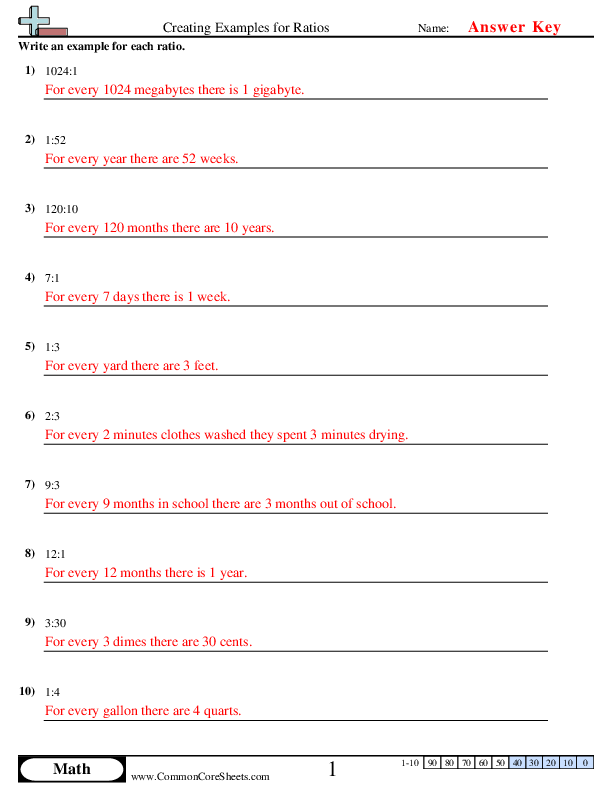
Creating Examples for Ratios
6rp1


×
Description:
"This worksheet is designed to enhance children's understanding of ratios in a fun and engaging way. Featuring 10 unique math problems, it uses real-life examples to teach the concept of proportional relationships. Ideal for distance learning, it can be easily customized, providing flexible formats such as flashcards. This indispensable learning tool links math understanding to the world around us, making complex concepts accessible and enjoyable for young learners."

×
Student Goals:
Conceptual UnderstandingUpon completion of the worksheet on Creating Examples for Ratios, students should have a robust understanding of the mathematical concept of ratios. They should be able to identify and understand the relationship between two quantities expressed as a ratio, as well as understand the role of ratios in different real-world contexts, such as time management, the economy, demographics, and data storage.Problem-Solving SkillsThe worksheet aims to enhance students' problem-solving skills. After careful practice, students should have the ability to interpret ratio word problems effectively and then apply their knowledge of ratios to solve these problems based on various topics and in real-life situations. This includes understanding what ratios represent and how they can be used to compare quantities or measure performance.Application SkillsStudents will acquire the skill to apply their knowledge of ratios in practical situations. This would include the ability to convert between units of measurements (i.e., Weeks to a year, currency, measurement units, etc.), understand the ratio in population statistics (i.e., Number of boys to girls), and understand and process ratios and proportions in the broader spectrum of mathematical understanding.Critical ThinkingThrough working on the given problems, students will improve their critical thinking capability. They should be able to make connections between real-world situations and mathematical ratios, which forms the basis for proportional reasoning. Students will learn how to simplify and compare ratios, leading to better decision-making skills and logical thinking.Enhanced Mathematical VocabularyBy the end of this worksheet, students will acquire a stronger mathematical vocabulary. They should be comfortable with terms like proportions, equivalent ratios, simplifying ratios, and more. Knowing the correct terminology is essential for understanding and discussing mathematical concepts effectively and accurately.PrecisionFinally, this worksheet should foster student growth in recognizing precision in mathematics. Recognizing the importance of accuracy in calculating and interpreting ratios will ensure that they understand the consequences of errors. This understanding will further aid in improving the precision of their mathematical work, a transferable skill set which holds great importance in all walks of life.



Identifying True and False Ratio Statements
6rp1


×
Description:
"This worksheet is designed to help children understand the concept of ratios in math in a fun and engaging way. It features 6 problems centered around everyday items and scenarios, helping children decipher true from false ratio statements. Converting this versatile resource into flashcards for easy review is a breeze. It is perfect for distance learning settings and can be customized to suit different learning needs and levels."

×
Student Goals:
Understanding Ratio StatementsUpon completion of the worksheet, students should have a thorough understanding of ratio statements. They will have learned how to identify ratios from given scenarios and apply their knowledge to interpret whether a ratio statement is true or false based on the provided context. This translates to an improved ability to interpret relational values in real-life situations.Problem SolvingThe worksheet will enrich the students' problem-solving abilities. By identifying true and false ratio statements through multiple choice problems, students will learn to solve mathematical problems analytically. This will not only sharpen their mathematical thinking but also enhance their strategizing and decision-making abilities.Critical ThinkingThe practice of determining true and false ratios requires careful reading and a keen sense of judgment, fostering critical thinking skills in students. This skill, vital both in and outside school, will be honed due to the interpretive nature of the exercises in this worksheet.Advanced Mathematical ConceptsCompletion of the worksheet will serve as a stepping stone towards understanding more advanced mathematical concepts. The basic understanding of ratios is a foundation for concepts like fractions, proportions, and similar figures. Hence, developing a clear understanding of ratios and how they function is important for students' evolving mathematical knowledge.Application of Math in Daily LifeBy completing the worksheet, students will learn how to apply mathematics to daily life scenarios. They'll understand the practical usage of math, specifically, how ratios function in everyday settings. This will ensure that students not only learn math theoretically but also realise its practical utility.Accuracy and PrecisionWorking on the worksheet will improve the students' accuracy and precision in mathematics. By identifying errors in false ratio statements, students will gain a heightened awareness of the importance of precision in mathematics.


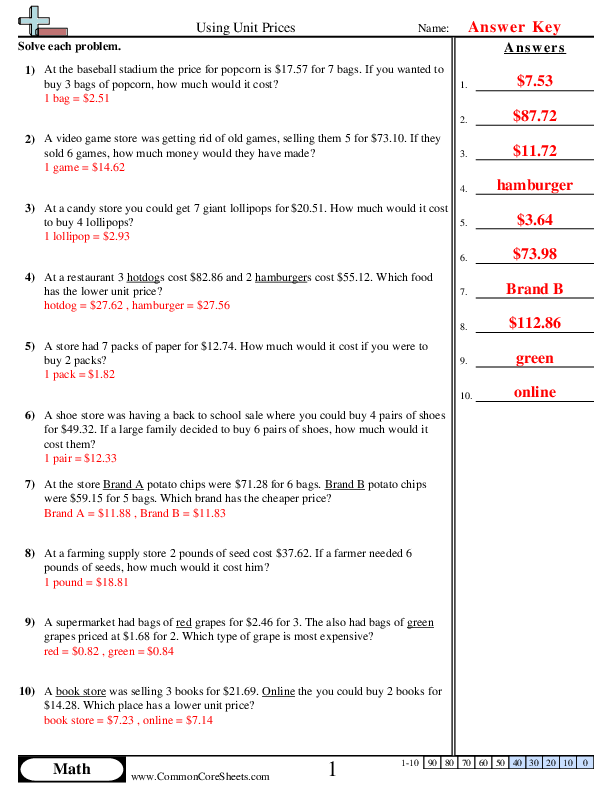
Using Unit Prices
6rp3b


×
Description:
"This worksheet is designed to enhance children's understanding of math through practical application, focusing on the concept of unit prices. It presents ten problems involving comparative shopping and budgeting scenarios, encouraging critical thinking and basic arithmetic skills. The worksheet can be customized for individual learning pace, converted into flash cards for interactive learning or employed in distance learning settings to suit unique educational needs."

×
Student Goals:
Understanding Unit PricesUpon completion of the worksheet, students should have a well-rounded understanding of unit prices. They will have confronted various real-life scenarios involving different items and quantities which will assist them in comprehending how the concept of unit price operates in everyday life. Students will be able to apply those concepts to new, similar situations they encounter.Comparative Shopping SkillsStudents will learn how to compare the prices of different brands or vendors of a given product in a market or store. They will gain the ability to decide which option provides the best value for money, enhancing their economic and financial awareness. This skill will be useful for efficient shopping and expenditure management in the future.Mathematical ProficiencyThe worksheet will enhance students' mathematical proficiency, specifically in operations involving division to determine unit prices. They will become more comfortable performing these operations and interpreting the results, strengthening their overall mathematical abilities and confidence.Decision-Making SkillsThe practice of deciding the better deal between different products or brands based on their unit prices encourages critical thinking and decision-making skills. This will assist students in making informed decisions, not only in a shopping context but also in other aspects of life that require similar analytical skills.Problem-Solving SkillsBy applying their knowledge of unit prices to real-world problems, students will develop essential problem-solving skills. These skills are not only applicable to mathematics but also other areas of life where they need to deduce solutions from given facts or conditions.Practical Transferable SkillsCompleting this worksheet will offer students practical, transferable skills. The ability to calculate and understand unit prices is useful both within and outside of a school context, equipping students with valuable tools they can use in their daily lives and in future careers.


Ratios and Unit Rates
6rp3b


×
Description:
"This worksheet is designed to teach children about the concept of ratios and unit rates in math. It contains 15 problems involving various contexts such as classrooms, CDs, game points, eating speed, ticket prices, earnings, snowfall, juice containers, TV commercials, and candy bags. Ideal for distance learning, its interactive format is customizable and can easily be converted into flash cards for convenient learning."

×
Student Goals:
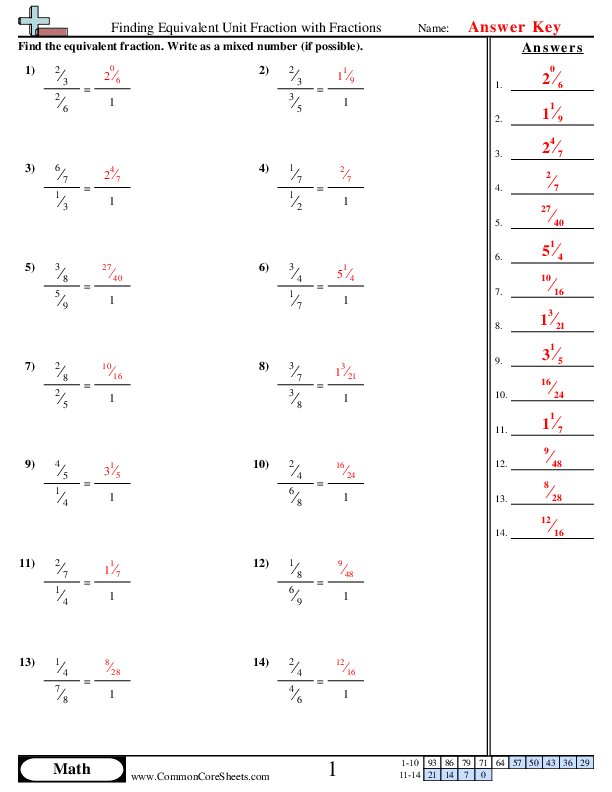
Finding Equivalent Unit Fraction with Fractions
7rp1


×
Description:
"This worksheet is designed to teach children about equivalent unit fractions in math. It contains 14 problems which introduce the concept of finding equivalent fractions and fosters critical thinking skills. Tailored for a customizable learning experience, this resource can be converted into flash cards for hands-on practice or utilized in distance learning settings. An essential tool for mastering fractions."

×
Student Goals:
Understanding Unit FractionsUpon completing the worksheet, students should have developed a grasp on the concept of unit fractions. Essentially, they should understand that a unit fraction is a fraction with a numerator of one. This foundational knowledge is critical in the study of more complex math topics as they advance in their studies.Recognizing Equivalent FractionsAnother achievement students should realize after successfully finishing this worksheet includes the ability to recognize equivalent fractions. This ability enhances numerical flexibility and allows students to manipulate numbers more effectively. Through the constant practice of such problems, students are expected to identify equivalent fractions with ease, thus improving mathematical agility.Discerning Non-Equivalent FractionsContrary to identifying equivalent fractions, students should also swiftly discern fractions that aren't equivalent after the completion of the worksheet. This proficiency in distinguishing non-equivalent fractions breeds confidence in dealing with mathematics problems that require quick and accurate identification of relationships between fractions.Solving Mathematical ProblemsAfter finishing the worksheet, students should be able to solve mathematical fraction problems more efficiently. They should be equipped with the problem-solving skills needed to approach math tasks and should be on their way to mastering the ability to apply these skills systematically in order to arrive at the most reasonable solution.Improving Mathematical Language UnderstandingCompleting the worksheet also improves students’ mathematical language understanding. They should be able to comprehend and apply mathematical terms, such as numerator, denominator, and equivalent, in a proper context. Hence, students are exposed to the necessary terminology that will likely be used throughout their mathematical education journey.Enhancing Numerical ReasoningFinally, students should be able to enhance their numerical reasoning skills after completing this worksheet. They should acquire the capability of thinking logically and analytically, making connections among mathematical ideas, and applying the appropriate strategies to solve fraction-related problems.


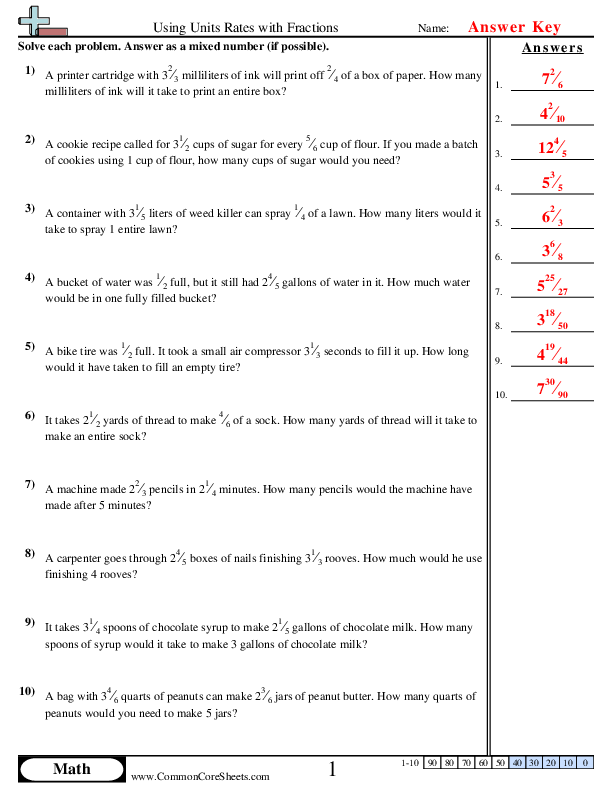
Using Unit Rates with Fractions
7rp1


×
Description:
"This worksheet is designed to enhance children's proficiency in math, specifically in using unit rates with fractions. Comprising of 10 hands-on problems, it provides scenarios involving various practical applications, such as measuring time, volume, and distance. Customizable to meet individual learning requirements, it can also be converted into flash cards for engaging study sessions or adapted for distance learning to facilitate continuous education at home."

×
Student Goals:
Understanding of Fractions and Unit RatesAfter completing these worksheet exercises, students should have significantly developed their understanding of fractions and unit rates. This understanding is not just in theoretical terms but in practical, real-world application scenarios as presented in the problems. They will be able to interpret and manipulate fractions in different contexts, gaining knowledge that is vital in both further mathematical studies and in daily life.Problem Solving AbilitiesStudents will have sharpened their problem-solving abilities by working through each task. The problems provided will challenge students to think critically about the provided scenario and figure out how to solve for the unknown. This analytical approach fosters the skills necessary in numerous future encounters, both scholastically and professionally.Enhance Critical ThinkingThese exercises will enable children to enhance their critical thinking abilities. The situations presented in the questions require a thoughtful analysis to resolve. Therefore, the sheet will be a tool for expanding strategic contemplation abilities in real-world situations, as well as complex mathematics.Real-World Math ApplicationHaving gone through the ten problems, the students will have experienced fractional scenarios based on real-life instances. They should now be capable of taking the abstract principles learned in class and applying them accurately to situations that they might encounter in daily life. Such an ability is crucial as it bridges the gap between theory learned and its use in the outside world.Time Management SkillsBy working through the math problems in this worksheet, students also get to improve their time management skills. Each problem requires a certain level of concentration and time commitment, and being able to balance this is a skill that students will find helpful in their future academic endeavors.Increased Confidence with MathSuccessfully navigating through this challenging, relatable, yet educational worksheet will imbue the student with increased confidence in handling mathematics problems, particularly involving fractions and unit rate. This can boost their overall interest in the subject and motivate them to tackle more complex problems in future.


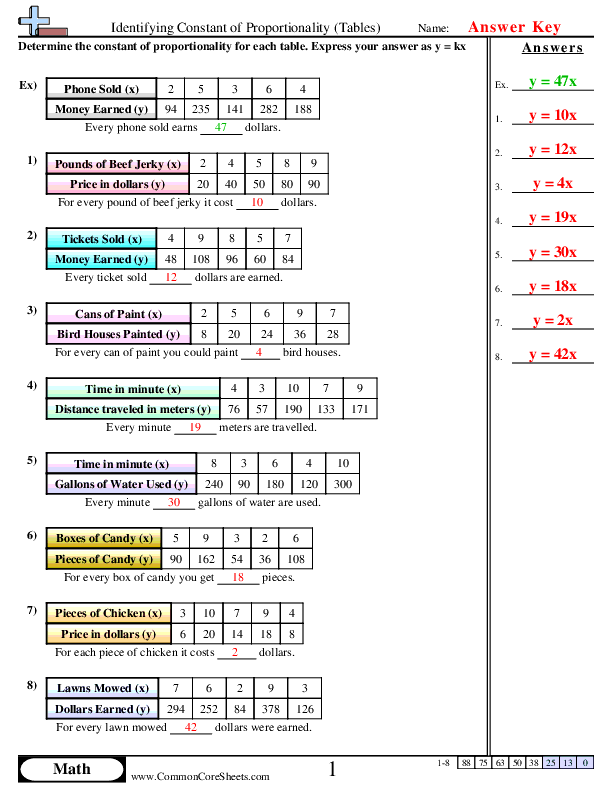
Constant of Proportionality (tables)
7rp2b


×
Description:
"This worksheet is designed to help children understand the concept of proportionality through real-life examples. It presents 8 diverse problems, from lemonade preparation to video game scores, testing kids on identifying the constant of proportionality in tables. In a fun, engaging format, it's versatile enough for any learning environment - customize for individual needs, convert to flash cards, or use in distance learning to enhance students' grasp of this essential math topic."

×
Student Goals:
Understanding Constant of ProportionalityUpon completion of this worksheet, students will have enhanced their understanding of the constant of proportionality. This key concept in mathematics, which is the consistent relationship between two variables, forms the basis for proportional reasoning. Mastering this skill will help students in comparing different scenarios, understanding rates and ratios, and solving practical everyday problems.Application in Real-World ScenariosThrough different practical problems, students will learn to apply their mathematical knowledge to real-world situations. By relating the concepts to familiar settings such as sales of items and measurements, students will be better able to comprehend the relevance and importance of constant of proportionality in everyday life situations.Problem Solving SkillsThis worksheet is designed to improve students' problem-solving abilities. Pupils will hone their skills to interpret tables, identify constants, and form mathematical relationships between different quantities. They will become adept at extracting vital information from given data, which is a valuable skill in tackling complex mathematical problems and in critical thinking.Mathematical Reasoning AbilityStudents will demonstrate growth in their mathematical reasoning abilities. This worksheet aims to make students more comfortable with proportional relationships, assisting them to form vital connections between different mathematical concepts. It will cultivate a deeper understanding of the wider mathematical framework.Preparation for Advanced Math ConceptsBy completing this worksheet, students will be better equipped for more advanced math concepts. Understanding the constant of proportionality is a fundamental building block for higher-level mathematics. This knowledge lays a strong foundation for topics like algebra, statistics, and calculus, setting students on a confident path to tackle more advanced studies.Improved Computation SkillsThe worksheet aids in honing the computation capabilities of students. They would get ample practice in multiplying and dividing numbers while finding the constant of proportionality from given data sets. It helps in achieving fluency in basic mathematical operations, improving their speed and precision.


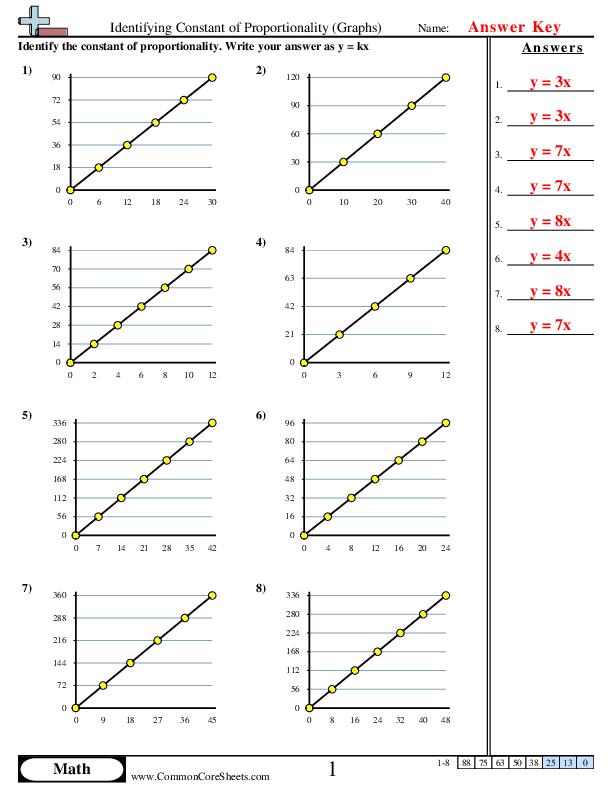
Constant of Proportionality (Graphs)
7rp2b


×
Description:
"This worksheet is designed to aid in mastering the concept of identifying the Constant of Proportionality in graphs in Math. Containing 8 engaging problems, it fosters an interactive learning experience for children. Notably, this adaptable worksheet can be customized according to individual needs, converted into flashcards for enhanced learning, or seamlessly incorporated into distance learning programs."

×
Student Goals:
Conceptual UnderstandingAfter completing the worksheet, students should have a solid understanding of the concept of the constant of proportionality in mathematics. They will be able to identify this constant in various graphical representations, fostering their ability to associate graphical patterns with mathematical concepts.Problem-Solving SkillsFurthermore, this worksheet will enhance students' problem-solving skills. They will learn how to work through complex problems involving constants of proportionality in graphs. This further nurtures their analytical thinking, a crucial skill not only in math but in all scientific subjects.Real-World ApplicationsUpon completion, students would be better poised to apply what they've learned to real-world scenarios. Constants of proportionality appear frequently in real-life situations, such as in calculations relating to speed, distance and time, among others. Students will, therefore, be better equipped to respond to math-related problems they encounter in everyday scenarios.Foundational Skill EnhancementThe worksheet will help students to solidify foundational math skills. Concepts like the constant of proportionality can be basis for learning more complex topics in mathematics. Mastering this concept would therefore give students a headway as they progress in their math learning journey.Interpreting GraphsCompletion of the worksheet would also mean that students are more proficient in interpreting graphs, a critical ability in many areas of study beyond math, including science and economics. They will be able to understand and interpret various forms of graphical data, a skill increasingly important in today's data-driven world.Time ManagementFinally, by working on the eight problems on this worksheet, students will subtly enhance their time management skills. They will learn how to strategically solve each problem within a reasonable time frame, an invaluable capability in timed tests and examinations.


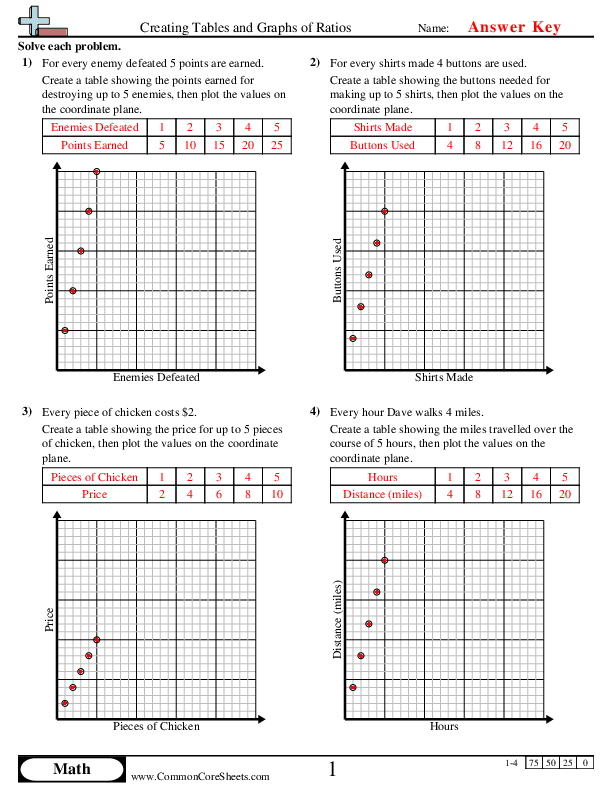
Creating Tables and Graphs of Ratios
6rp3a


×
Description:
"This worksheet is designed to teach children the concept of ratios through practical problem-solving exercises. It contains four interactive math problems that require creating tables and graphs using provided real-life scenarios. The worksheet can be personalized to suit individual learning needs, used as flash cards for easy memorization, or incorporated into distance learning curriculum. It offers an engaging way to build fundamental math skills."

×
Student Goals:
Understanding RatiosUpon completing the worksheet, students should have a solid understanding of ratios and their practical application. They will have hands-on experience with creating ratio tables, allowing them to visually grasp the proportional relationship between a pair of numbers. This fundamental knowledge will make subsequent topics easier to understand, such as rates, fractions, and percentages.Plotting on Coordinate PlaneStudents should be proficient in plotting points on a coordinate plane, a vital skill they will continually need throughout their mathematical education. They will gain experience in transforming data from ratio tables into graphs. This will lay the foundation for future studies in graphing, data analysis, and spatial thinking.Real World ApplicationsStudents should have the ability to apply the concept of ratios to real-world scenarios. The worksheet provides practical examples related to everyday life, like shopping and gaming, making the abstract concept of ratios more tangible and relatable. This meet should lead students to realize the value of math in daily situations, ultimately instilling a more positive attitude towards the subject.Problem SolvingThe worksheet should enhance students’ problem-solving skills. By provided problems of varying complexity, it will challenge students to think critically and devise an effective approach to finding solutions. This experience should improve their capacity to tackle an array of mathematical problems.Conceptual UnderstandingFinally, students should develop a deep, conceptual understanding of the relationship between quantities. The process of creating ratio tables and graphs takes them beyond just memorizing procedures and moves towards understanding why those procedures work. This kind of understanding is crucial for learning higher-level math concepts in the future.




